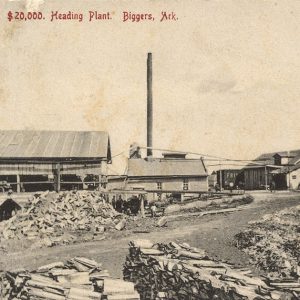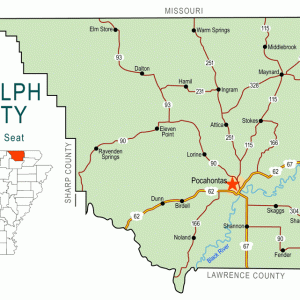calsfoundation@cals.org
Biggers (Randolph County)
|
Latitude and Longitude: |
|
|
Elevation: |
285 feet |
|
Area: |
1.00 square miles (2020 Census) |
|
Population: |
305 (2020 Census) |
|
Incorporation Date: |
February 18, 1903 |
Historical Population as per the U.S. Census:
|
1810 |
1820 |
1830 |
1840 |
1850 |
1860 |
1870 |
1880 |
1890 |
1900 |
|
– |
– |
– |
– |
– |
– |
– |
– |
– |
– |
|
1910 |
1920 |
1930 |
1940 |
1950 |
1960 |
1970 |
1980 |
1990 |
2000 |
|
435 |
447 |
466 |
456 |
333 |
274 |
372 |
363 |
337 |
355 |
|
2010 |
2020 |
|
|
|
|
|
|
|
|
|
347 |
305 |
|
|
|
|
|
|
|
|
Located on the Current River near the Cherokee Bay in the southeastern Randolph County lowlands, the town of Biggers developed around 1900. While scattered settlements may have been present in the region from 1815 to 1830, the first major development near the modern site of Biggers was the plantation of Thomas Drew, who later served as the governor of Arkansas. Drew received the land from Dr. Ransom Bettis upon Drew’s marriage to Bettis’s daughter Cinderella; he developed the land and had amassed around twenty slaves by 1832. Bettis also continued to own land near the future Biggers site.
In 1889, B. F. Bigger, the namesake for the town, bought land, established a ferry crossing over the Current River, and built a distillery. Due to the completion of the Southern Missouri and Arkansas Railroad line from Hoxie (Lawrence County) to Poplar Bluff, Missouri, in 1901, the town of Biggers coalesced around the train depot. That same year, the St. Louis–San Francisco Railway (Frisco) system purchased the line and carried it on to Cape Girardeau, Missouri, thus creating a number of market opportunities for the citizens of Biggers.
Due to rich timber resources, Biggers quickly developed as a lumber mill town. The Bank of Biggers opened in 1902, and the Ida Mae Hotel, a twenty-four-room structure, opened in 1906. By 1910, the town could boast a doctor, a grist mill, a butcher shop, several saloons and soft drink shops, a millinery store, and several general merchandise and grocery stores. Over time, the timber industry began to decline, but the cleared land easily converted to row crops, cotton being the most common. Accordingly, other businesses opened, including a cotton gin, a shoe store, a filling station, and a tomato canning factory. In 1928, U.S. Highway 67 was paved through the town, providing another economic outlet for the town’s products. The new U.S. Highway 67 still runs through the community.
An important landowner in the Biggers area was Coleman C. Scott, who was African American. Establishing his farm in 1899, Scott improved his holdings to around 1,000 acres, requiring the employment of at least a dozen workers by 1910. Amassing considerable wealth, Scott established Scott’s Ferry and donated land for a school for African Americans and a Methodist church. He died in 1927.
By the 1930s, the economic fortunes of the town had declined. The reduction in agricultural prices and various Depression-era woes eventually forced the Bank of Biggers and Biggers stores to move to Pocahontas (Randolph County). As agriculture became more mechanized and farms began to merge into larger tracts after World War II, the number of people employed in agriculture dropped, and the town continued to decline.
During World War II, some 1,200 Randolph County men, including several from the Biggers region, were called into service. On the home front, Biggers was one of five auxiliary airfields supporting the Walnut Ridge Army Flying School in Walnut Ridge (Lawrence County).
In 1946, the public schools of Biggers and Reyno (Randolph County) were consolidated into Biggers-Reyno District No. 87. In May 2006, the final class graduated, and the remaining students went to surrounding districts. The school was a major source of employment for the town, which continues to struggle after its closure. The census shows that Biggers’s population has fallen to 347, and the estimated median income dropped from $26,250 in 2000 to $21,641 in 2010. Because agriculture remains the primary economic activity in the Randolph County lowlands, the people of Biggers will most likely maintain their small town by continuing to provide support for the farmers in the region.
For additional information:
Dalton, Lawrence. The History of Randolph County. Little Rock: Democrat Printing and Lithographing Company, 1946.
Lamb, Mary, and the 1985 Government Class. History of Biggers-Reyno. N.p.: n.d.
Randolph County, Arkansas: History and Families. 2 vols. Nashville, TN: Turner Publishing Company: 2001, 2008.
Derek Allen Clements
Black River Technical College
 Biggers Flood
Biggers Flood  Biggers Plant
Biggers Plant  Biggers Street Scene
Biggers Street Scene  Randolph County Map
Randolph County Map 



Comments
No comments on this entry yet.